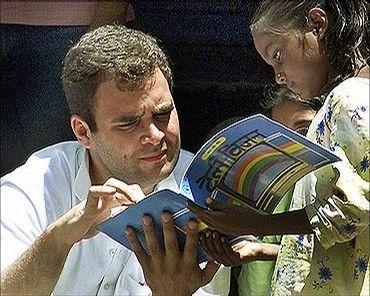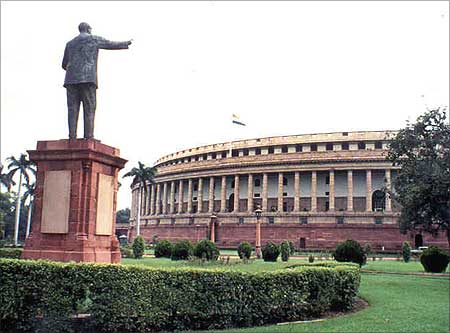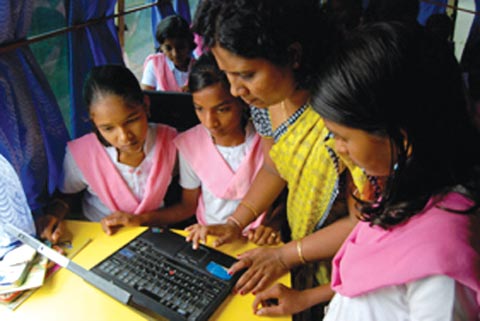
Poverty in the Indian context can never be wiped through direct state intervention. Kalavati is a classical example of this. The only way of eradicating it is by encouraging personal initiatives. Jasuben is a classical example of this, says M R Venkatesh
Kalavati shot to fame when Rahul Gandhi [RaGa for the party faithful] mentioned about her in the Parliament. Since then, her pathetic and tragic personal life has become a part of our political discourse. In fact, she represents all that is wrong with policies, plan and programs of our government.
Hailing from India's 'suicide belt' Kalavati's husband, a farmer committed suicide in 2005. Her son-in-law, and later her daughter too, reportedly committed suicide. A mother of nine [possibly this is where the government should have intervened, yet it failed] and with no means to support her family Kalavati's heart rending story could move anyone to tears.
It was therefore appropriate that Rahul Gandhi visited her to learn her problem -- in effect the nation's problem -- firsthand. If press reports and charges made by his political opponents are to be believed, despite this much hyped visit, not much has improved with Kalavati.
No wonder when Gujarat Chief Minister Narendra Modi [Namo to party faithful] addressed the annual general meeting of FICCI Ladies Organisation recently and referred to Kalavati, her wretched life and personal tragedy has once again has come to dominate the national political discourse.
...

Contrasting the story of Kalavati to Jasuben, a woman from Gujarat, Modi brought out the success stories of women entrepreneurs if given the right opportunity. Jasuben, according to press reports, set up her version of a pizzeria nearly 40 years ago in Ahmedabad. To pander to the local palates, she added a dash of sugar and jaggery to her pizza toppings.
According to Modi, her pizzas competed successfully with well-known international brands in Gujarat. Hinting at the divergence in the real life story of two women Modi concluded, "But before our friends from the media go there to find out if Jasubehn is like Kalavati, I would like to tell them she died five years back. Her pizzas, however, still have a big market."
Unmistakably, the narrative of NaMo is that Jasuben's success was a by-product of his government's economic policies. On the other hand, supporters of RaGa believe that hope and succor to Kalavati could flow only through direct government intervention. The fault lines in their approach to the idea of India could not have been more explicit.
Given this paradigm, the Indian media, as is its wont, missed the bus to fashion the agenda for the forthcoming elections. In the process the ideological debate of an ideal, effective and efficient economic model suited for the Indian environment has degenerated into crass, crude and personality based discussion of NaMo versus RaGa.
Ideally, the reference to Kalavati and his comparison to Jassuben by Modi should have brought the ideal role of government and model of governance into sharp focus. What is the role of government? How should it compliment personal initiatives and entrepreneurship? Crucially, how should it encourage individual initiatives and create wealth?
...

The basic question that appears since the dawn of civilization is the appropriate relationship between state, society and individuals. Should the nascent Indian state lead an ancient society with no role for individual or social initiative? If so, how? Or should it be the other way around where the state is left to play a marginal role? These questions continue to haunt us even six decades after independence.
The ancient Chinese caught the essence of this role-play through their image of their ideal king, who sits facing south doing nothing and lets the natural course of events flow uninterrupted. This doing nothing and letting things happen requires a great deal of effort. It requires being deeply aware of and sensitive to the times, mood and aspirations of the people.
Likewise, under the classical Indian thought, the state is never the instrument of change or reform. This of course does not mean that there are no mechanisms or possibility of change. Nevertheless, such initiative for change does not lie with the king. The impulse for reforms arises deep within the society, articulated by sages and is works itself through different constituents.
At the very end of the reforms process a fresh balance and a new order is created.
The western idea of the government is exactly the opposite of what the ancient Chinese and Indian philosophers had laid out, probably best articulated by Plato. In his conception, the state and is institutions are the only legitimate actors in the public domain so much so there are only atomised, powerless and unattached individuals at the command of the state.
Consequently, according to Plato, individuals have no separate identity of their own living at the whims and mercy of the state. In fact, the State determines the number of kinds of people it requires; brings together the right type of genetically endowed parents and thus creates the appropriate raw material for the creation of the ideal polity.
Put pithily, you will be determined by the government even before you are born!
The Platonic society is thus an entirely man made construct with no place for anything natural in it. The order and balance is decreed by the state through the legislation and coercion. The whole edifice thus serves the reasons for the state and there is no place for anyone else.
These ideas have further been refined and modernised by philosophers like Francis Bacon, Thomas Hobbes and probably even Karl Marx. For them, man within his natural setting is a dangerous person who must be uprooted from his natural mooring, purged of his dignity and made into an obedient individual sub-serving the designs of the state.
Nevertheless, this idea by the second half of twentieth century had run its full course. Having allowed the proliferation of the modern state into a large monolith and operating through an inefficient yet ruthless bureaucracy, experiences of the past five decades or so across continents have demonstrated the inefficiency of this model.
The admission of this folly and reversal of the grand idea of state as a central and possibly the only force in the nation building process goes up with a sexed up appellation of reforms. India is no exception to this grand global experiment of finding the right balance between society, individual and the state.
...

Reforms by definition implies less, not more, of government -- a fact lost on those who believe that the only way to richness for Kalavati is through state intervention and not by her personal initiatives. And how does government gets its money for spending on Kalavati? Of course by taxing Jasubens of the world!
While most western countries have seen the futility of fashioning society as argued by Plato and hence believe in reforms -- read less of government -- India the original land of less government is arguing for more government. All this while the Indian government officially proclaims that it is in reforms mode!
This is not to argue that Kalavati does not require state intervention. Surely she requires our collective support. But doles that perennially keep her alive but below subsistence level are not the right model. Unfortunately, the RaGa model of development precisely believes in this idea.
The ministry for women affairs must have intervened when she had more than two children. It did not. The ministry of health must have helped her. It did not. The agricultural ministry must have helped her husband. It did not. The human resources ministry must have helped her children. Yet it did not. The ministry of water resources as well as ministry for rural affairs helped all of them. They did not.
If all these ministries of the government of India had failed where is the question of taxing Jasuben in the name of helping Kalavati?
Whatever be it, a weak, inefficient and ineffective delivery mechanism cannot be the panacea for all the ills plaguing Kalavati. Yet unarguably she requires maximum intervention of our government. That is possible only through laser like governance models that identifies her, her problems and delivers the needful through a clockwork precision.
Poverty in the Indian context can never be wiped through direct state intervention. Kalavati is a classical example of this. The only way of eradicating it is by encouraging personal initiatives. Jasuben is a classical example of this.
It is time that someone tells Rahul Gandhi that his model is nothing new. In fact it has been tested for at-least 60 years since the days of his great grandfather. Yet it has not succeeded in the Indian context. For starters he must readily admit that this idea of attempting to hand out doles has run its full course. Equally he must admit that the entire delivery mechanism too has failed.
Therefore the only way out is allowing Jasuben to flourish by repealing our labour laws, lower taxes and our government providing better infrastructure. Rahul Gandhi and his advisors must realise that their electoral battle is not with NaMo. Rather they must realise that their ideas are anachronistic.
Unfortunately, Rahul Gandhi is silent on all this.
The author is a Chennai-based chartered accountant. He can be contacted at mrv@mrv.net.in
...